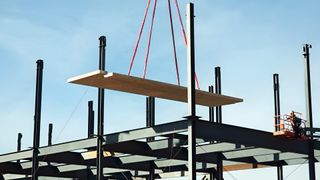Microsoft's building data centres out of wood hoping we'll forget AI's made its carbon emissions 29% higher than when it pledged to go 'carbon negative' in 2020
Well, they're not entirely made from wood and the computers certainly aren't, so there's still more scope for going totally carbon zero.

Traditional data centre buildings are standard industrial constructions, with steel and concrete being the main materials. In a bid to reduce its carbon emissions, Microsoft is currently building two new data centres that use a hybrid wood construction, that the software company claims has a 35% lower carbon footprint than other standard designs.
Wood is perhaps the last material that one would associate with hulking servers and associated buildings, but that's precisely what's being used, according to a news report by Microsoft (via The Register).
Strictly speaking, it's using a kind of plywood called cross-laminar timber (CLT)—thick layers of wood glued together, with the grain of each piece at right angles to the one underneath it.
CLT has been around for a long time and it's a pretty decent building material: lighter than steel and concrete, with good thermal insulation properties.
It's also a lot more eco-friendly than precast concrete, partly because it can be made from a sustainable source but also because the process of making it generates far fewer carbon emissions than either steel or concrete.
It's this aspect of CLT that's the reason behind Microsoft's choice of using it for two new data centre builds in North Virginia, USA. Steel is still being used for the frame and concrete for the foundations, but most of the floors and ceiling (and possibly walls) are going to be CLT.
"The hybrid mass timber, steel and concrete construction model is estimated to significantly reduce the embodied carbon footprint of two new datacenters by 35 percent compared to conventional steel construction, and 65 percent compared to typical precast concrete," says Microsoft.
The biggest gaming news, reviews and hardware deals
Keep up to date with the most important stories and the best deals, as picked by the PC Gamer team.
While I'm sure those figures are genuine for this particular project, it feels somewhat like a drop in the ocean compared to the overall carbon footprint of a typical data centre.
Depending on the size, such facilities use a lot of electricity and it's estimated that in the US alone, the total power consumption could hit 35 GW by 2030—potentially doubling the carbon emissions seen today.

Windows 11 review: What we think of the latest OS.
How to install Windows 11: Our guide to a secure install.
Windows 11 TPM requirement: Strict OS security.
The reason why I mention that specific year is that it's also the deadline Microsoft has set itself for being carbon-negative (i.e. its total carbon offset and capture footprint is larger than its emissions).
Not that this is going particularly well right now, as Microsoft's carbon emissions are 29% greater than they were in 2020 when it set the carbon goal, due to building more data centres for AI.
Now, I don't believe for a moment that Microsoft thinks that two wooden builds are going to make much of a difference here, especially in light of how much energy they're going to consume, but every little helps.
CLT is a bit more expensive than standard steel and precast concrete builds, so Microsoft is at least putting its money where its mouth is.
I think I might have an idea for something it could try to further cut down on carbon emissions, though. How about it stops adding AI to everything it makes, so fewer AI servers are needed? Yeah, I guess not.

Nick, gaming, and computers all first met in 1981, with the love affair starting on a Sinclair ZX81 in kit form and a book on ZX Basic. He ended up becoming a physics and IT teacher, but by the late 1990s decided it was time to cut his teeth writing for a long defunct UK tech site. He went on to do the same at Madonion, helping to write the help files for 3DMark and PCMark. After a short stint working at Beyond3D.com, Nick joined Futuremark (MadOnion rebranded) full-time, as editor-in-chief for its gaming and hardware section, YouGamers. After the site shutdown, he became an engineering and computing lecturer for many years, but missed the writing bug. Cue four years at TechSpot.com and over 100 long articles on anything and everything. He freely admits to being far too obsessed with GPUs and open world grindy RPGs, but who isn't these days?

After closing its AAA games development studio, Netflix Games VP transforms into the VP of GenAI for Games and the gobbledygook must flow: 'a creator-first vision… with AI being a catalyst and an accelerant'

OpenAI has bought the URL of what used to be an adult video chat website for more than $15,500,000
Most Popular







